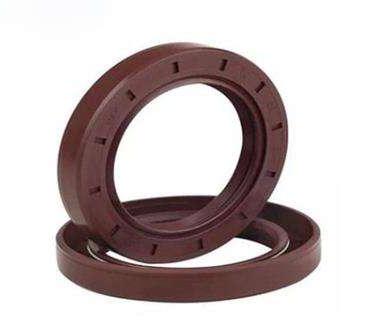The skeleton oil seal belongs to the dynamic sealing component, and the existence of a "critical oil film" is a sufficient and necessary condition for the sealing of the skeleton oil seal. A leak free sealing is not allowed and impossible. The existence of a lubricating oil film is essential to ensure lubrication and friction at the edge of the skeleton oil seal, and the presence of a lubricating oil film makes a certain amount of leakage inevitable. For rotary skeleton oil seal components, it is allowed to experience slight leakage within the initial 50-100 hours of operation during use. As the operating time increases, the leakage will gradually stop, and often this type of skeleton oil seal has a longer lifespan.
During the effective use period, minor leakage is allowed, otherwise, it must be handled according to the common causes and troubleshooting methods of the skeleton oil seal components as follows.
Poor sealing of the skeleton oil seal, causing early leakage
1. Poor lip of the skeleton oil seal seal
Cause analysis: Poor manufacturing quality, burrs or defects on the edge of the skeleton oil seal seal;
Troubleshooting: Remove burrs or replace the skeleton oil seal.

2. Poor quality or failure of the spring of the skeleton oil seal seal
Reason analysis: The manufacturing quality of the spring for the skeleton oil seal is poor;
Troubleshooting: Replace the framework oil seal spring.
3. Excessive radial pressure
Cause analysis: The spring is too loose and the clamping force is too small;
Troubleshooting: Adjust the framework oil seal spring.
Poor assembly of the skeleton oil seal seal and leakage
1. There are obvious scars on the lip of the skeleton oil seal seal
Cause analysis: During assembly, the skeleton oil seal component scratched the lip through keyways or threads;
Troubleshooting: Replace the skeleton oil seal seal; When reinstalling, use a protective sleeve to protect the lip of the skeleton oil seal.
2. The skeleton oil seal seal has butterfly shaped deformation
Cause analysis: Improper installation tools for skeleton oil seal seals;
Troubleshooting: Redesign and manufacture installation tools for skeleton oil seal seals.
3. The assembly direction of the lip of the skeleton oil seal seal is reversed or the spring is loose
Cause analysis: Improper installation tools for skeleton oil seal seals;
Troubleshooting: Redesign and manufacture installation tools for skeleton oil seal seals.
4. Excessive grease applied to the lip and shaft surface of the skeleton oil seal seal
Cause analysis: During assembly, excessive grease was applied to the lip of the skeleton oil seal and the surface of the shaft;
Troubleshooting: After the shaft has been running for a period of time, the grease can decrease and return to normal.
The lip of the skeleton oil seal is worn
1. Poor lubrication, severe wear on the working surface of the lip of the skeleton oil seal, with a width exceeding 1/3, resulting in a dull appearance
Cause analysis: Poor lubrication, dry friction at the lip of the skeleton oil seal;
Troubleshooting: Ensure the lubrication of the skeleton oil seal components.
2. The surface roughness of the shaft is higher than 0.8
Cause analysis: The surface roughness of the shaft is low, and the lip of the skeleton oil seal is severely worn;
Troubleshooting: Reduce the surface roughness of the shaft to below 0.8.
3. Lubricating oil contains dust, impurities, or the absence of a dust cover can cause the invasion of dust, foreign objects, etc
Reason analysis: The oil used is not clean, and the hydraulic pipeline system is too dirty; Abnormal wear caused by dust and other intrusion into the lips; Sticking powder hard particles on the shaft; During assembly, iron filings, etc. are punctured into the lips; Ingress of casting sand into the lip; Incorrect paint on the lip of the shaft or skeleton oil seal;
Troubleshooting: Ensure lubrication and cleanliness, strengthen pipeline system cleaning; To prevent dust and other substances from invading the lips, dust prevention devices are added; During assembly, pay attention to cleanliness and remove misapplied paint.
4. The pressure on the lip diameter of the skeleton oil seal is too high, causing the oil film to break and dry friction to occur
Cause analysis: The spring of the skeleton oil seal seal is too tightly held;
Troubleshooting: Adjust the framework oil seal spring.

5. The installation is eccentric, and the lip of the skeleton oil seal sliding shows abnormal wear, with the maximum and minimum wear widths symmetrically distributed; The size of the wear marks on the sliding surfaces of the main and auxiliary lips of the skeleton oil seal is symmetrically distributed with each other, but the size and position are opposite
Cause analysis: The box, end cover, and shaft are not concentric, causing the eccentric operation of the skeleton oil seal components; The seat hole of the skeleton oil seal seal is too small and improperly pressed into the skeleton oil seal, resulting in tilting;
Exclusion method: Ensure the concentricity requirements of the box, end cover, and shaft; Ensure the size requirements for the seat holes of the skeleton oil seal components.
The compatibility between the skeleton oil seal and the working medium is poor, and the lip of the skeleton oil seal is soft, swollen, hardened, or cracked
Cause analysis: Improper connection between the skeleton oil seal and the working medium;
Exclusion method: Select a suitable working medium based on the material of the skeleton oil seal seal or choose a suitable skeleton oil seal material based on the working medium.
Rubber aging of skeleton oil seal sealing element
1. The lip of the skeleton oil seal is overheated, hardened, or cracked
Reason analysis: The working medium temperature of the skeleton oil seal is higher than the design value, exceeding the durability limit of the rubber;
Troubleshooting: Reduce the temperature of the working medium or replace it with a heat-resistant rubber skeleton oil seal.
2. Poor lubrication, hardening or cracking of the lip of the skeleton oil seal
Cause analysis: Poor lubrication of the skeleton oil seal and dry friction;
Troubleshooting: Ensure that the skeleton oil seal is lubricated.
3. Swelling and softening of the lip of the skeleton oil seal
Reason analysis: Poor compatibility of rubber with working media; The skeleton oil seal is immersed in washing oil or gasoline for a long time, causing the lip of the skeleton oil seal to swell;
Exclusion method: Select rubber materials that are compatible with the working medium or choose working media that are suitable for rubber materials; Do not use wash oil or gasoline to clean the skeleton oil seal seals.
Reason for shaft
1. Surface roughness, above 0.8 or below 0.2
Cause analysis: The surface is rough and severely worn; The surface is too smooth, making it difficult to form and maintain a lubricating oil film, resulting in dry wear;
Exclusion method: Reduce the surface roughness to below 0.8; Improve the surface roughness to above 0.2.
2. Improper surface hardness, higher than HRC40
Reason analysis: The experiment shows that when the surface hardness of the shaft is higher than HRC40, it actually accelerates the wear of the shaft (except for surface chrome plating);
Exclusion method: Keep the surface hardness between HRC30 and 40, and chrome plating on the surface is the best.
3. Lubricating oil contains impurities and the surface is severely worn
Reason analysis: The lubricating oil is not clean;
Troubleshooting: Ensure that the lubricating oil is clean.
4. Excessive eccentricity, causing noise when the shaft shakes radially
Cause analysis: bearing eccentricity; The shaft itself is eccentric;
Troubleshooting method: Replace the bearing and use a eccentric resistant skeleton oil seal.
5. Dust at the lip and severe wear on the shaft surface
Reason analysis:
The surface of the shaft is unclean, adhering dust particles, invading the lip of the skeleton oil seal, and wearing the surface of the shaft;
Invasion of casting sand and wear on the surface of the shaft;
External invasion of dust, wear on the surface of the shaft;
Deterioration of lubricating oil, generation of oxides, intrusion into the lip of the skeleton oil seal, and wear on the surface of the shaft;
Exclusion method:
Ensure the cleanliness of the shaft surface and skeleton oil seal components;
To prevent external intrusion of dust, dust prevention devices are installed;
Use high-quality lubricating oil instead.
6. There are scratches or sand holes on the sliding surface of the shaft
Reason analysis:
There are process cracks or corrosion spots on the surface of the shaft, which exacerbate wear and leakage;
The gap between the scratches, sand holes, etc. on the surface of the shaft and the lip of the skeleton oil seal, resulting in leakage;
Scratches or bumps on the surface of the shaft;
Troubleshooting: Ensure the surface quality of the shaft and do not touch it.
7. There are directional machining marks on the sliding part of the shaft surface
Cause analysis: There are micro thread grooves and other turning or grinding marks left on the surface of the shaft, resulting in pump suction and leakage;
Exclusion method: Ensure the precision machining process of the shaft surface. Experience has shown that it is best to use small glass balls with a diameter of 0.05mm for shot peening treatment.
The existence of a "critical oil film" at the edge of the skeleton oil seal is very beneficial for reducing the wear of the edge of the skeleton oil seal and increasing the service life of the skeleton oil seal. Especially when several skeleton oil seals are used in parallel, special attention should be paid to the supply of lubricating oil (grease). Otherwise, dry friction will be formed due to oil shortage, resulting in the burning of the skeleton oil seal. Generally, lithium based grease is the best choice.
To ensure the cleanliness of the lubricating grease and timely eliminate impurities or other harmful impurities accumulated in the grease, it is important to regularly replace the lubricating grease. Therefore, in terms of structural design, it is necessary to leave oil injection and drainage holes. In order to prevent the temperature of the sealing chamber of the skeleton oil seal from rising, it is sometimes important to open a vent hole.











